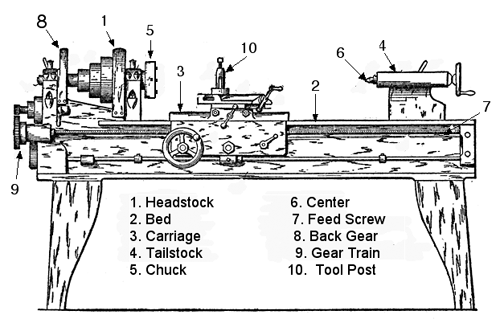
Parts of a Lathe
|
The illustration below is an older style lathe, the function of the components remains the same on newer style lathes. Do a visual check of each component, checking for damage, missing or broken parts, make sure all moving parts move freely without too much slop.
1. Headstock This is a heavy casting for the spindle, drive pulley, and back gear. Most lathes have timken bearings but some older models had babbit or bronze bushings. There must be no play in the bearings. 2. Bed The lathe bed is the backbone of the lathe so must be ridgid, and machined perfectly true. The top surfaces of the bed are the ways, one or both may be vee shaped. Be suspicious of any damage to the ways. 3. Carriage The carriage slides along the ways of the bed, a cross-slide is attached to it to hold an angle slide and the tool post. The part that extends down the front is the apron which houses the manual and automatic mechanism for the longitudinal feed. There should be no play in any of the cross-slides or where the carriage rides on the ways. Check the gears behind the apron for damage. 4. Tail Stock The tail stock is used to support the outer end of work being turned with the use of a dead or live center. It is also used for boring holes by inserting a drill bit chuck with a tapered stub into the spindle. The spindle should not have any play in the tail stock casting and it should move freely. 5. Chuck The chuck holds material to be turned, 3 jaw automatic and 4 jaw independent types are the two most common. Check the jaws for signs of wear, is the wrench included. 6. Center Centers are used in the head stock and tail stock to support material being turned when great accuracy is required. Check the internal tapers for damage such as scratches or burrs as well as the tapers on any centers or other tapered accessories. 7. Feed Screw The feed screw drives the carriage, the speed is determined by the gear train configuration. Check for any damaged, chipped or broken threads. 8. Back Gear The back gear is necessary for screw cutting, through it the gear train is engaged. Check for missing or badly worn teeth. 9. Gear Train The gear train determines the speed of the feed screw, slow for machining, faster for screw cutting. Check for missing and damaged teeth, there should be a chart for the different gear configurations, make sure all the gears are included 10. Tool Post The tool post holds the cutting tool, older lathes have the lantern style shown where the height of the cutting tool is adjusted by rocking the holder. Newer style lathes are equipped with a QCTP (Quick Change Tool Post) where each holder has a locking adjustment so the height does not have to be set each time it is put on.
|
` |
